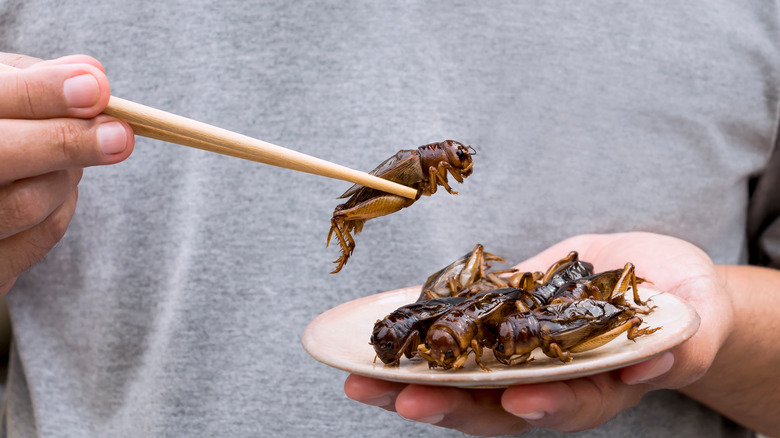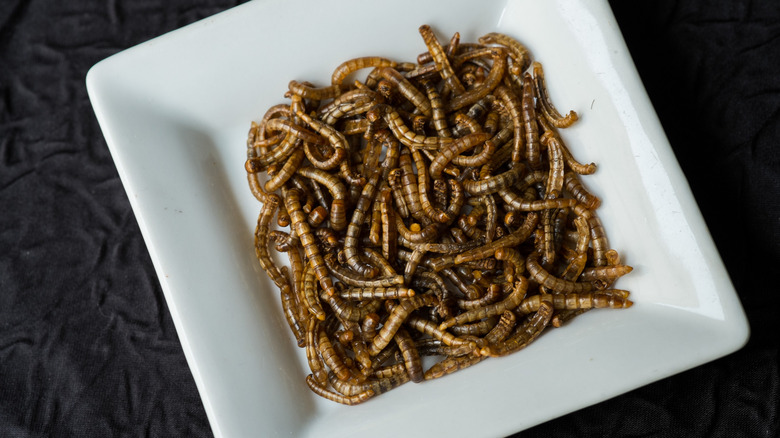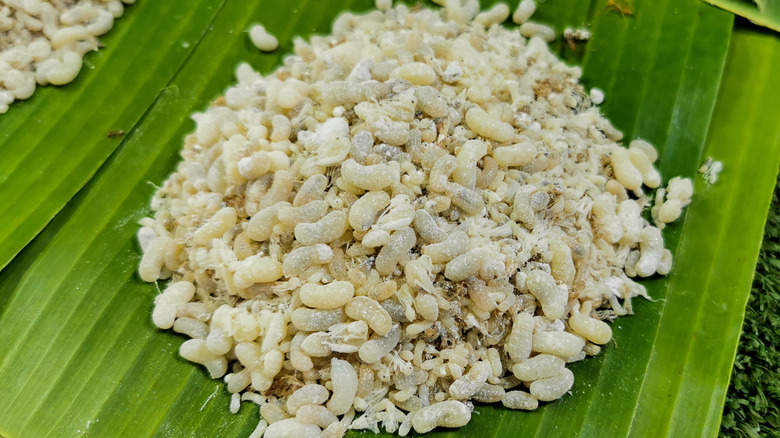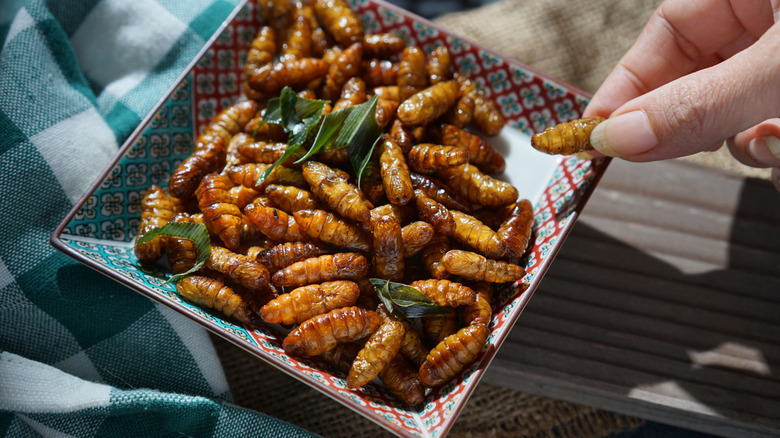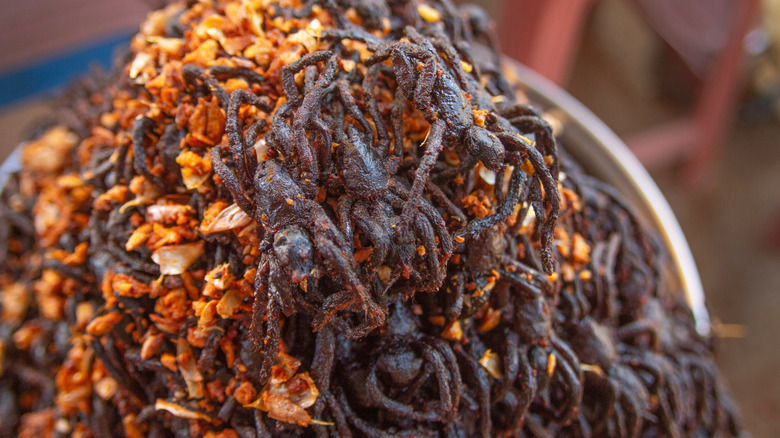12 Most Nutritious Bugs You Might Actually Want To Cook With
Creepy crawlies as decorations for your home might be a natural go-to at Halloween, but what if they could be a nutritious addition to your meals? Incorporating bugs into your diet can be good for your health and the health of our planet. If you're looking for a sustainable way to eat healthy, bugs may be for you!
Entomophagy, the practice of eating bugs, isn't a new idea. Cultures across the world have been eating bugs for thousands of years. With more than 2,000 species of edible bugs, the possibilities are endless. However, it has yet to catch on in many Western cultures where eating bugs is often seen as a taboo or novelty.
We spend so much of our time trying to stay away from bugs, why should we start eating them? The benefits of incorporating bugs into a diet are undeniable, and research into the health benefits of bugs shows that bugs are high-quality protein sources. Insects are not only high in protein but are chock-full of amino acids, unsaturated fats, and minerals that are essential to a healthy diet.
Bugs are the more sustainable protein option. Despite the fact that more crickets must be raised to equal the same amount of protein as cattle, crickets require 2,000 times less water. Insect agriculture may be the perfect sustainable alternative to animal protein. Bugs can play a significant part in reducing world hunger, protecting the planet, and improving your health.
1. Crickets
If you want to hit your protein goals, crickets can get you there. High-protein foods are all the rage these days, what if eating crickets could be like eating a high-protein potato chip? These little chirping critters are often roasted with a delicious seasoning you might find in your favorite bag of chips.
Crickets are full of vitamins and minerals that are critical to a healthy diet. They are a great source of essential vitamins A, B12, C, D, E, and K. Their mineral composition is impressive; calcium, potassium, magnesium, phosphorus, sodium, iron, zinc, manganese, and copper can all be found in these six-legged creatures. Even though bugs have no bones, the minerals found within them support healthy strong bones. Cricket flour can be used as a gluten-free flour substitute. This flour is 70% protein by weight, using it in your baking can make any recipe high in protein.
In terms of sustainability, crickets are unique in their ability to be raised vertically in temperature-controlled environments. This allows compact, year-round, sustainable production of protein. This requires fewer resources and acres of land compared to livestock farming.
If you want to try incorporating crickets into your meals, they can be a great addition to many of your favorite recipes. Tacos, curry, brownies, pasta — the possibilities are endless. Using cricket alternatives can increase the nutritional value of any meal.
2. Beetles
The Beatles may be the most popular band in the world, but beetles are the most popular edible insect. There are many different species of beetles in the world, but the most common edible beetle is called Holotrichia parallela. These round little arthropods shouldn't be underestimated when it comes to nutritional strength.
The protein content of beetles is comparable to a delicious cut of beef or pork at 70.57 grams of protein per 100 grams. However, beetles may be a cut above beef and pork because of their low fat content. High-fat consumption is associated with many different health concerns such as coronary heart disease, obesity, and can even lead to cancer.
Like crickets, beetles have essential vitamins and minerals to help you achieve ideal daily intake levels. Potassium, calcium, phosphorus, magnesium, manganese, copper, zinc, and iron can all be found in these little insects. Essential amino acids are also found in beetles. Amino acids are what make up protein, while our body produces some amino acids, there are nine amino acids that our bodies need that we are unable to create ourselves, these are essential amino acids. All nine essential amino acids can be found in H. parallela. Amino acids aid in many of our bodies' functions such as digestion, sleep, detoxification, and serotonin production.
The bodies of beetles can be roasted into a crunchy snack and served with your favorite sauce on the side. Different kinds of beetles are also made into scones.
3. Mealworms
If you're an exotic pet owner, you may have fed mealworms to your lizard, but have you ever considered giving them a try yourself? High in fiber, protein, healthy fats, and micronutrients, these little critters can be the key to a healthy diet.
Like crickets and beetles, mealworms are high in protein, but offer additional nutrients as well. Mealworms are high in fiber, which regulates many of our body's systems. Although too much fiber can have negative effects, the right amount is essential. Fiber promotes regular and healthy bowel movements, controls blood sugar levels, lowers cholesterol, and leaves you more satisfied. The filling feeling of fiber can promote weight loss, leaving you satiated longer. These larvae are also great carbohydrates that can help provide the energy needed to tackle the day.
Like crickets, mealworms are also used to create gluten-free flour alternatives and can be incorporated into almost anything. In fried rice, blueberry crumble, mac and cheese, and so many other dishes, mealworms are a very popular addition to recipes.
4. Ants
Ants on a log are a classic childhood treat, but real ants can be just as delicious and more nutritious. Ants are eaten in all stages of life as eggs, larvae, and adults. Ants are a popular dish across continents, being enjoyed in Africa, Asia and Latin America. Like most bugs, ants are high in protein but what sets them apart is their rich flavor and oxidative stress-fighting properties.
There are a wide variety of ant species, making them a very versatile ingredient. Ants like weaver ants and black ants have a high acidity, making them a wonderful addition to a fish soup. This is how ants are often utilized in Laos. In Mexico, leaf cutting ants are used to flavor condiments such as mayonnaise. Weaver ants have a very alluring aroma, with notes of nuts and sweet caramel — roasted weaver ants smell scrumptious. The flavors and smell of ants comes from their pheromones used to communicate with other ants.
Ants have antioxidants like zinc that fight oxidative stress in our body and like most insects, are also high in fiber due to the chitins found in their exoskeleton. This is insoluble fiber, meaning it can not be digested by the body, which helps to quicken the process of digestion.
5. Grasshoppers
Grasshoppers are a delicious part of many cuisines across the world, but are one of the few bugs that have snuck their way into American culture. Grasshoppers are a popular snack at T-Mobile Stadium home of the Seattle Mariners. Chapulines, toasted grasshoppers tossed in a chili-lime seasoning, are eaten by Mariner's fans enjoying America's favorite pastime.
Grasshoppers are not only eaten as a snack, but also a part of meals. Grasshopper tacos and stir fry are delicious ways to incorporate these insects into your diet. South American, African, and Australian dishes feature grasshoppers, with the nutty flavor and crunch of grasshoppers being compared to a tasty handful of peanuts.
A study done at the University of Dschang in Cameroon shows that grasshoppers' variety of vitamins, protein, and amino acids, and essential minerals can improve many aspects of your physical health. Their research compared the impact of protein sources on the health of rats, and grasshoppers provided the most ideal outcome. Rats on a grasshopper diet showed improvements in hair health, sleep, and sexual function compared to rats consuming other protein sources.
6. Caterpillars
Caterpillars are a delicacy and important fixture of culture in southern African countries. The caterpillar of the mopane moth is a nutritional staple and used in many dishes as a protein source. These little guys waiting to become butterflies can do wonders for your body and provide nutrients that are not found in many diets. If you're a meat lover, these may be the protein substitution for you. They are described as having a meaty flavor with a juicy texture comparable to beef.
Caterpillars contain zinc, which can be deficient in certain diets, but it is incredibly valuable for a healthy diet. Zinc helps to fortify the immune system, helping our bodies fight off colds, infections, and heal wounds. They also contain magnesium, which is known to calm the body. Magnesium strengthens the nervous system allowing for neurotransmitters to travel through the body and relaxes muscles. If you're prone to the common cold, noshing on caterpillars may be immune system defense you're looking for.
7. Giant Water Bugs
Giant water bugs stand out from the pack due to their large size, they are about the length of a human finger with impressive long front legs. These swimming insects can be found across the globe in both North and South America, Asia, and Australia and are commonly eaten in Asia and Mexico. Giant water bugs are not only good for you but have an interesting taste and aroma that can elevate recipes.
Giant water bugs are described as tasting like scrambled eggs and black licorice, an unlikely but enjoyable combination. They are often boiled or fried, and unlike many bugs, their exoskeletons are often discarded. To prepare water bugs their shells and wings are removed, and sometimes used to flavor sauces.
These bugs are an amazing protein source and high in minerals such as zinc and iron. What really sets them apart is their calcium content. The calcium in giant water bugs supports healthy strong teeth and bones. Our bodies don't produce calcium, but it is vital to our health. Giant water bugs would be a great addition to the American diet because they are often calcium deficient.
8. Scorpions
You may have seen a scorpion inside of a lollipop, but these desert dwellers can be eaten in many different ways. Scorpions are a popular food in Asia. In China, scorpions are traditionally used in medicine for their fabled healing properties. These stories might not be too far off, because scorpions are very nutritious.
Eating scorpions may seem scary, but if prepared properly they are safe to eat. The venom found in a scorpion's intimidating stinger is stored in the top two segments of a scorpion's tail and should be cut off before eating. The venom in scorpions is also neutralized by heat during the cooking process. If you're brave enough to eat a scorpion you will find they are very tasty. The flavor of scorpions is often described as a cross between crab and chicken. These ferocious arachnids are often fried, grilled, or roasted.
Scorpions are a nutrient rich protein source and are full of vitamins and minerals. Notably, they contain selenium, a mineral that our bodies can not produce but supports many crucial functions of the body and can protect against disease. The mineral is known to support thyroid health and protect the reproductive system, helping your body maintain a healthy metabolism and fight off free radicals damaging your cells. Selenium also may reduce the effects of asthma and protect against cancers. Scorpions can also aid in regulating blood sugar levels, increasing the body's energy and mental health.
9. Termites
Termites might be bad for the health of your home, but they can be great for a healthy diet! Termites are enjoyed worldwide as a crunchy snack in Africa, Asia, and South America. These tiny creatures are full of fatty acids, minerals, and vitamins.
Termites are often dried or roasted and eaten as a crunchy snack or used as a delicious topping. You might use termites as a replacement for croutons on your salad, or as flour for baking. Many enjoy termites on their own, eating them with savory flavors like chips and they're described as having a fresh flavor like fruits and vegetables.
Termites are full of fatty acids, vitamins, minerals and antioxidants. Omega-3 and omega-6 fatty acids in termites are crucial to our diets. Omega-3 fatty acids are polyunsaturated fats, a kind of fat that our bodies can only obtain through diet. These are complicated fats made up of double bonds that aid our bodies in numerous ways. Omega-3s keep our hearts beating stead, fight off depression, manage weight, reduce inflammation, and strengthen brain development. Omega-6 fatty acids are similar to omega-3s with more carbon atoms. Their benefits are very similar, but research shows that omega-6s in particular can be used to treat chronic disease.
10. Flies
Flies are plentiful, you may experience them flying around your yard or your home in large numbers. The large number of flies in the world makes them a super-sustainable protein option, and their tiny size makes them a perfect snack. Flies are commonly eaten in Africa, but could be useful all over the world.
Flies and their larvae can be used to create a high-protein patties as a beef replacement or ground up and used as an additive. Not only are flies good for humans but they can be used as livestock feed. Livestock can be rough on the environment, creating livestock feed takes up valuable farmland, and flies can be a healthy and sustainable replacement.
Flies are low-calorie and high-protein little bugs. Although flies aren't as full of fatty acids as some insects this may create a better flavor profile over other insect proteins. If you can get over the "ick" factor, eating flies may be a way to control a pest problem if you're frequently visited by flies.
11. Tarantulas
If you're someone that suffers from arachnophobia, reframing these scary critters as a delicious meal may help! Tarantulas are commonly eaten in Cambodia fried and are a great source of folic acid.
For those that eat them, tarantulas are a delicacy rather than something to fear. These spiders have a shellfish flavor being described as shrimp or crablike with a crispy exterior and soft interior. They are often rolled in savory and sweet coatings such as garlic and sugar before being fried or grilled.
These arachnids are high in folic acid which is particularly important during pregnancy.Folic acid is used to prevent birth defects such as spina bifida, which results in a baby's spine not fully forming in the womb. Folic acid also makes for a healthy brain, preventing strokes, fighting off mental illness, and protecting our brains from mental decline decline.
12. Dragonflies
Dragonflies are a beautiful sight flying through the sky, but you may have never considered that they can be a flavorful treat. Dragonflies are eaten in Japan for their medicinal qualities, cooked or snatched straight out of the air. Dragonflies and damselflies are said to taste like chicken sashimi, a popular food in Japan. In Indonesia, dragonflies are fried in coconut oil and laid across fluffy hills of rice for Bali. Dragonflies can be eaten on their own but if the idea of chomping on one by itself isn't your thing, they also work as a delicious ingredient in tamales, tacos, and other dishes.
These flying bugs are high in protein, low in fat, and can have a huge impact on energy levels. What sets them apart from other insects is their lipid content. Lipids help to store energy, digest fat, and protect our cells from intruding molecules. This paired with a high level of essential vitamins makes dragonflies part of a well-balanced diet.

